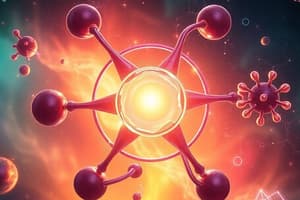Podcast
Questions and Answers
What is the smallest unit of an element that retains its chemical properties?
What is the smallest unit of an element that retains its chemical properties?
- Neutron
- Proton
- Nucleus
- Atom (correct)
Which subatomic particle contributes to the atom's identity and determines its atomic number?
Which subatomic particle contributes to the atom's identity and determines its atomic number?
- Proton (correct)
- Electron
- Neutron
- Nucleus
What does the mass number of an atom represent?
What does the mass number of an atom represent?
- Number of neutrons
- Number of protons
- Atom's mass but not its identity (correct)
- Number of electrons
What is defined as the number of protons in an atom's nucleus, unique to each element?
What is defined as the number of protons in an atom's nucleus, unique to each element?
What are atoms of the same element with different numbers of neutrons called?
What are atoms of the same element with different numbers of neutrons called?
What is the central core of an atom containing protons and neutrons, and carries a positive charge due to the presence of protons?
What is the central core of an atom containing protons and neutrons, and carries a positive charge due to the presence of protons?
What are the distinct regions around the nucleus where electrons are likely to be found called?
What are the distinct regions around the nucleus where electrons are likely to be found called?
What is the mass and charge of a neutron?
What is the mass and charge of a neutron?
What effect do neutrons have on the physical properties of the element?
What effect do neutrons have on the physical properties of the element?
What term is used to describe atoms of the same element with a different number of neutrons?
What term is used to describe atoms of the same element with a different number of neutrons?
How is the 'relative' atomic mass of an element standardized?
How is the 'relative' atomic mass of an element standardized?
What is used to calculate the 'relative' atomic mass (Ar) of isotopes?
What is used to calculate the 'relative' atomic mass (Ar) of isotopes?
What determines which isotope's mass should be used on the periodic table if there are different isotopes of an element?
What determines which isotope's mass should be used on the periodic table if there are different isotopes of an element?
What is another name for 'Chlorine-35' and 'Chlorine-37' based on their isotopic composition?
What is another name for 'Chlorine-35' and 'Chlorine-37' based on their isotopic composition?
How many neutrons does each chlorine isotope have?
How many neutrons does each chlorine isotope have?
What does 'Ar' stand for in chemistry when discussing isotopes?
What does 'Ar' stand for in chemistry when discussing isotopes?
Flashcards are hidden until you start studying




